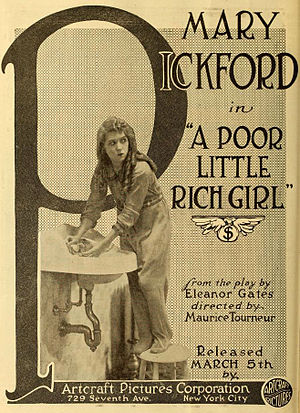The Poor Little Rich Girl
Jump to navigation
Jump to search
| The Poor Little Rich Girl | ||||||||||||||||||||
|---|---|---|---|---|---|---|---|---|---|---|---|---|---|---|---|---|---|---|---|---|
This film has been preserved in the National Film Registry in 1991.
| ||||||||||||||||||||
 | ||||||||||||||||||||
|
The Poor Little Rich Girl is a 1917 American comedy-drama film directed by Maurice Tourneur. Adapted by Frances Marion from the 1913 play by Eleanor Gates. The Broadway play actually starred future screen actress Viola Dana. The film stars Mary Pickford, Madlaine Traverse, Charles Wellesley, Gladys Fairbanks (returning from the play) and Frank McGlynn Sr.
Why It Rocks
- This film marked a turning point in Mary Pickford's acting career as it's the first time in adulthood that she played a little girl. Mary was 25 at the time and there were so many ways this couldn't have worked out. But despite all odds, Mary completely sells the act and is not only convincing as an 11-year-old girl, she even manages to come off as cute and adorable. Pickford can even change emotions shockingly quickly depending on the situation, similar to how an actual child may do so. Mary was so talented, she was typecasted to continue playing little girl roles.
- Adding to the previous pointer, props must be given to the set designers and casting crew. The "child" illusion was enhanced with specially scaled sets and props that made Mary look smaller, and also by casting unusually tall actors as the "grown-ups", or have them stand on books. It's all enough to dupe the audience into falling into the illusion.
- Gwendolyn is an incredibly sympathetic protagonist. Even though she's constantly neglected by her busy parents and servants are all super overprotective of her, she's still very optimistic, spirited, and active. She's also incredibly sweet and polite despite being super-wealthy.
- Incredible acting from everyone involved in the film.
- Aside from all of the heartbreaking scenes with Gwen, there's also a fair amount of humorous scenes to balance it out, including a mud fight that takes place in the greenhouse of Gwendolyn's home or a child sitting on a pie.
- During the climax, there's a great, powerful, and often hilarious scene of surrealism during the dream sequence that offers metaphors for her life and the people she's known.